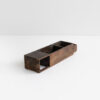Eduardo Chillida (1924-2002) was a Spanish sculptor best known for his striking, abstract, and minimalist steel sculptures. His works are characterized by a timeless beauty and simplicity that made him one of the most important artists of the 20th century. Chillida is probably known for his sculptures, but in this portrait, I would also like to explore his graphical works.
Chillida was born in 1924 in a small coastal town called San Sebastián in Spain. In 1943 he studied architecture but dropped out after three years to devote himself entirely to art. 1948 he moved to Paris for 3 years and set up a studio there. In the early days of his artistic career, Eduardo Chillida devoted himself to figurative sculpture, focusing on the simplified human form.
This emphasis was encouraged by his friendship with the abstract painter and sculptor Pablo Palazuelo, as well as by ancient Greek sculptures that left a lasting impression on him in the Louvre in Paris.1 In 1951 he returned to Spain. At this time, Chillida experimented a lot with iron, wood, and steel – the latter becoming one of the defining characteristics of his later work.
Chillida’s work is characterized by a deep connection to nature, as well as an exploration of space and the void. Throughout his life, Chillida traveled to many other countries and explored inspirations from different cultures. The San Sebastián Coast and the Basque culture in which Eduardo Chillida grew up also had a strong influence on his work.
In my work, I have never had any use for anything that I have known in advance.
Eduardo Chillida
Many of his sculptures have references to nature and the landscape, such as his famous “Peine del Viento” sculptures, which are among his most important and well-known works. An ensemble of three monumental steel sculptures are set into the rocks above the water at the western end of La Concha Bay in San Sebastián, interacting with both the wind and the waves of the sea.
Although his engravings, drawing, collages, and lithographs did not gain as much recognition as his sculptures, they were nonetheless an influential part of his artistic output. With them, he explored space and emptiness by combining simple geometric shapes and textures. Initially, he cut into the paper, but in the 1980s he replaced this technique with the concept of collage (his so-called “Gravitaciónes”).2
In this way he created an inspiring harmony and balance of volume and materiality, light and shadow. He combines minimalism and complexity while conveying a sense of calm and stillness. Jess Harrison of FineArtMultiple magazine uses the accurate statement that Chillida enacts a “dialogue between the full and the empty.”3
Chillida died in his hometown on August 19, 2002, at the age of 78. His legacy and influence continue to this day, and his minimalist aesthetic remains an inspiration to many contemporary artists. Many of his sculptures, which appear to be both massive and weightless, are on display in major museums and public spaces throughout Spain. They are still an invitation to reflect the natural forces and the space they occupy.
Further Reading / Resources
1 https://ocula.com/artists/eduardo-chillida/artworks/medium/all/order/recent/1/
2 https://www.hauserwirth.com/artists/2864-eduardo-chillida/#biography
3 https://fineartmultiple.com/blog/eduardo-chillida-drawings-sculptures-hauser-wirth/
https://www.lempertz.com/de/kataloge/kuenstlerverzeichnis/detail/chillida-eduardo.html
Interesting Article with a video about the Chillida Leku project: https://www.hauserwirth.com/ursula/24304-chillida-leku-home-eduardo-chillida/


